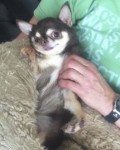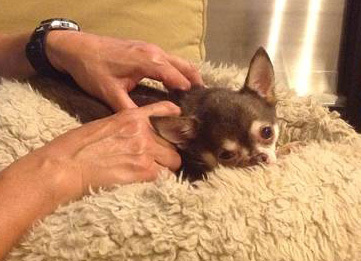Canine Acupressure: How to Work with a Difficult Dog
By Gretchen Dietz
The first words out of Bob’s mouth aren’t nice ones. If he had thought bubbles, they’d be censored. An 8-year-old Chihuahua, scurries across the living room paddling his crippled and unusable left front leg while tossing his small head back in a fit of angry commentary. It’s been this way since I met Bob… almost two years ago!
Bob was rescued as a puppy and while his legs weren’t nearly as deformed as they are now (particularly the left front), his body has always been slightly contorted and in much need of body work. The only problem has been that no one could get near Bob. He’d snap. He’d charge. He’d bite. And yes, he barked – incessantly and loudly.
Working with difficult dogs is a bit like solving a puzzle. Every dog is different and every difficult dog is particularly different when it comes to touch. Understanding body language helps a great deal as does a heavy dose of patience. With Bob, I didn’t attempt to touch him at first. Instead, his owner placed him in his bed and placed the bed on my lap. I sat with him, my hands by my side, and never gave direct eye contact. I yawned occasionally, asked permission to touch him, and just waited for a sign that he was ready.
The first touch was to his lower back, partly because that was the area doing all the work given his crippled front body, but also to protect myself from being bitten. I didn’t really know what to expect, but to my surprise, Bob pushed into my hand and remained there.
 Of course, the next session he growled and snapped at me when I reached for his back so again I waited, I yawned, I asked permission, and soon he shimmied up sideways and leaned his belly into mine. To my surprise, I spent the session working his Conception Vessel and once again, he fell asleep.
Of course, the next session he growled and snapped at me when I reached for his back so again I waited, I yawned, I asked permission, and soon he shimmied up sideways and leaned his belly into mine. To my surprise, I spent the session working his Conception Vessel and once again, he fell asleep.
Session after session the same routine played out. He’d bark, I’d wait, and then he’d choose the area of concern and I’d figure out what points were close by that might need attention.
Once, for instance, his guardian reported Bob had bouts sneezing and gooey nasal discharge. During the session, Bob pressed his lower neck and upper thoracic spine allowing me to work Bl 13, the Association point for Lung. The moment I touched those bilateral points, he laid his head down on the edge of the bed and fell into a deep sleep allowing me to reach my forefingers around his shoulders to reach Lu 1 – the Alarm point for Lung, which benefits the regulation of the Lungs and Upper Heater and promotes of the descending of Lung chi.
I have learned a great deal working with Bob, but chief among my lessons is that animals get to decide the direction of the  session. I am not in charge. I have also learned that many animals have a “relaxation point” or a point, when worked, sends them into a calmer state. As much as I’d love for it to always be the same point for every animal I work with, it’s not. For Bob, the combination of Bl 13 and Bl 18 stops the barking and agitation, but he’ll have nothing to do with GV 20, a traditional calming point and forget about even considering Yin Tang on the bridge of his nose.
session. I am not in charge. I have also learned that many animals have a “relaxation point” or a point, when worked, sends them into a calmer state. As much as I’d love for it to always be the same point for every animal I work with, it’s not. For Bob, the combination of Bl 13 and Bl 18 stops the barking and agitation, but he’ll have nothing to do with GV 20, a traditional calming point and forget about even considering Yin Tang on the bridge of his nose.
When I’ve finished my session with Bob, I place my hands on the area he allows and thank him. He seems appreciative though the second I set him down on the floor his commentary begins again loudly and persistently. I’ve come to realize this is just Bob’s way of thanking me with a few choice words of canine profanity. Or maybe he knows how much he’s helped me build my skills when working with difficult dogs.



